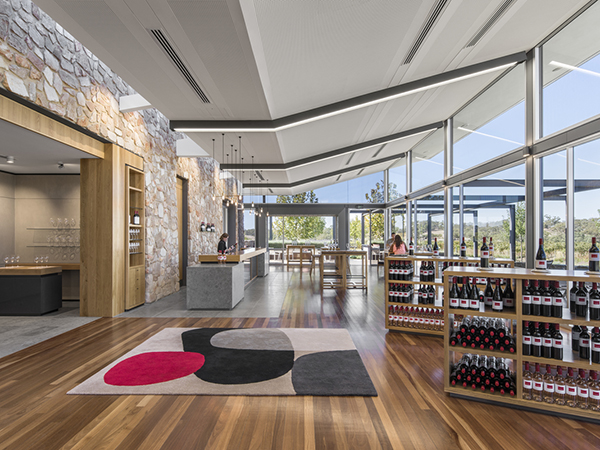From the architect:
Designlnc director Richard Stafford designed Barossa Valley Estate’s original facility in 1999.
Twenty years on, the bones of the pavilion-style building were strong, with its stone spine wall, framed views of the Barossa ranges to the south-east and Marananga village to the north.
However, the interiors needed refreshing and spaces lacked connection with their surrounds. DesignInc worked with landscape designer Paul Bangay to create a setting for the building where architecture and landscape are interwoven.

The visitor experience begins with a curving driveway that meanders through the landscape revealing and framing different views to create a sense of journey and arrival. An imposing stone wall at the end of the carpark mimics the spine wall. On passing through a small opening in this wall, the pavilion and expansive landscape views are revealed, punctuated by a bright red door inviting the visitor to step inside.
The refreshed interior is light and airy with a simplified layout creating an open-plan area with spectacular views from every position. A limestone tasting counter in front of the stone wall welcomes visitors to begin their wine experience. Furniture and furnishings define the spaces, with low and high tables for sitting and relaxing or stand-up tastings. External areas offer informal settings for groups to gather, taste the wines and enjoy the views.

A suite of decks, terraces and arbours connect and integrate the building into its environs. Collaboration with Paul Bangay on the hard landscaping, finishes and detailing ensured alignment and consistency between architecture and landscape.
Traditional Barossa materials of American oak, limestone and concrete are used in a contemporary way to complement the original palette. The connection between architecture and landscape, wine and landscape, wine and the Barossa captures the Barossa Valley Estate experience and establishes a genuine sense of place.

A suite of decks, terraces and arbours connect and integrate the building into its environs. Collaboration with Paul Bangay on the hard landscaping, finishes and detailing ensured alignment and consistency between architecture and landscape.
Traditional Barossa materials of American oak, limestone and concrete are used in a contemporary way to complement the original palette. The connection between architecture and landscape, wine and landscape, wine and the Barossa captures the Barossa Valley Estate experience and establishes a genuine sense of place.
“It is very rare as an architect to have the opportunity to renovate a building that was a pivotal early project in your career. Reimagining a unique cellar door in a beautiful corner of the Barossa Valley and working with a client who values quality and detail, was an absolute privilege,” says, Richard Stafford, director, DesignInc Adelaide.

